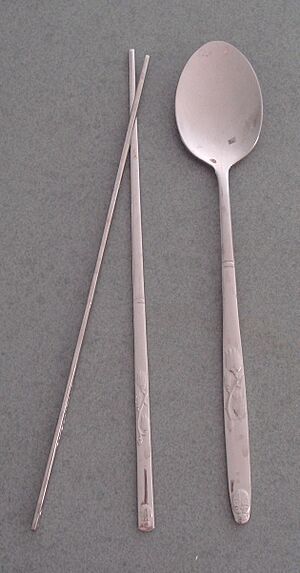Sujeo facts for kids
| Sujeo | |

Sujeo, a set of Korean eating utensils.
|
|
Quick facts for kids Korean name |
|
|---|---|
| Hangul |
수저
|
| Revised Romanization | Sujeo |
| McCune–Reischauer | Sujŏ |
Sujeo (수저) is the Korean word for the special set of eating tools used in Korean cuisine. It's a combination of two words: sutgarak (숟가락), which means 'spoon', and jeotgarak (젓가락), which means 'chopsticks'.
A Sujeo set usually includes a pair of metal chopsticks and a long-handled, shallow spoon. These are often made from stainless steel. The chopsticks can be oval-shaped or have rounded-rectangular ends.
You might see people using both the spoon and chopsticks at the same time. This is a newer way to eat faster. However, it's not considered good manners, especially when eating with older people, to hold both in one hand. Often, people eat most of their food using only the chopsticks. Sometimes, the word sujeo is used just to mean the spoon itself, separate from the chopsticks.
Sujeo Etiquette: How to Use Them
There are some important rules for using Sujeo in Korea. You can place your chopsticks on the table when you're not using them. But you should never stick them upright into your food, especially into a bowl of rice. This is because it looks like food offerings made at a grave for people who have passed away. Doing this is thought to bring bad luck.
The spoon can be placed on the edge of your rice bowl or soup bowl if you haven't used it yet. Korean meals are often eaten quite quickly, and the food portions are usually small. Because of this, people don't spend much time putting their eating tools down during a meal.
Sujeo as Gifts and Souvenirs
In the past, special cases for Sujeo were often given as gifts. These cases were made from paper or traditional Korean fabrics. They were frequently decorated with beautiful embroidery, showing symbols that meant long life. These were very popular gifts, especially at weddings.
Today, Sujeo sets are still popular. You can often find them sold as souvenirs for visitors to Korea. They make a nice reminder of Korean culture and traditions.
See also
 In Spanish: Sujeo para niños
In Spanish: Sujeo para niños

